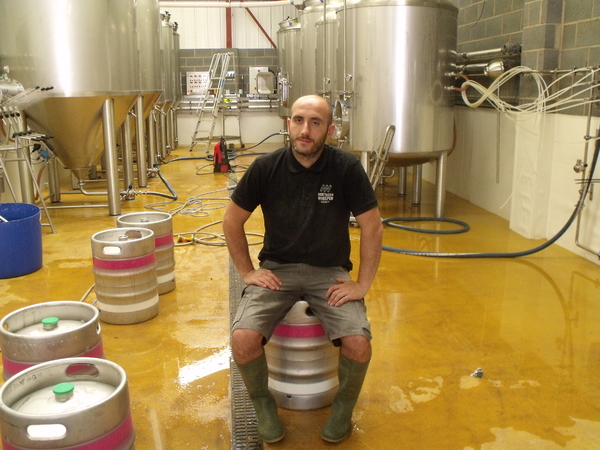Full steam ahead to two great rail bars
Added: Sunday, July 8th 2018
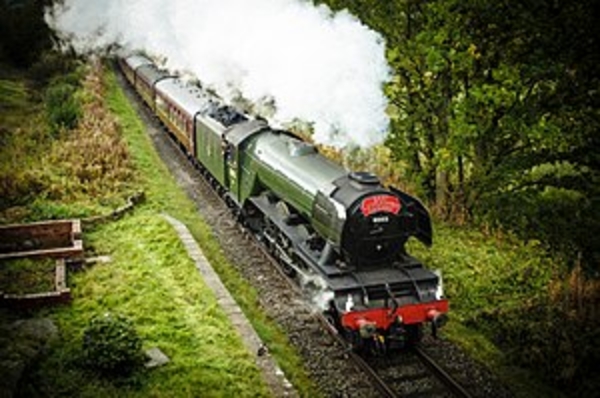
If you have a twin passion for good beer and steam trains then the East Lancs Railway and two magnificent station bars will have you purring with pleasure. The bars offer a fine range of ales and lagers, and they help celebrate the restoration of a line that was one of the victims of the notorious Beeching axe in the 1970s.
The line today is run by volunteers who man trains, both steam and diesel, which run from Rawtenstall to Ramsbottom via Bury. The East Lancs reopened in 1987, an opening that was marked by the majestic huff and puff of the Flying Scotsman loco (top image).
If you join the train at Rawtenstall – pronounced “Rottenstall” – you can sample the aptly named Piston Broke from Outstanding Brewery in the Buffer Stops bar at the station, where Rachel Schofield (below) pulls the pints.
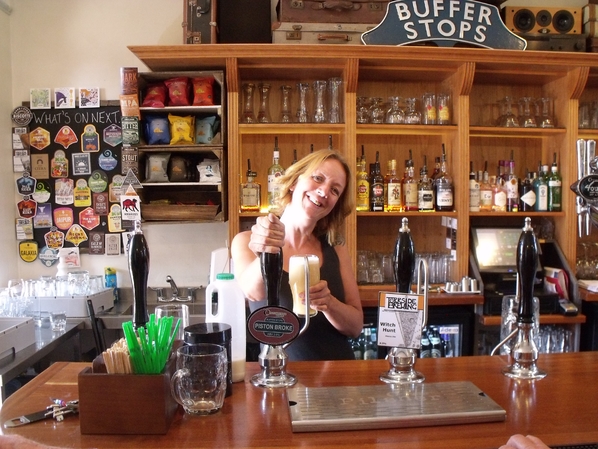
The bar is located in the former station cafe but the building has been opened up, with additional seating, along with railway and brewing memorabilia, in the ticket hall and waiting room. There’s also ample seating outside where visitors can watch the trains arrive and depart. The platform also houses a large beer “cellar” in a former station building as the pub has no formal cellar.
There was large and cheerful group in the waiting room sampling Piston Broke and some of the guest beers – there are always four guests on tap. The group sported shirts with a logo called LOTSWAG. It turns out LOTSWAG has nothing to with wives or partners of the England football team but stands for Last of the Summer Wine Appreciation Group.
The diehard fans of Compo, Cleggy and Nora Batty (below) had journeyed up from Chester for the day and after a short stop for oiling and greasing at Rawtenstall they planned to take the train to Bury and back. As they were also keen CAMRA members, we had a chin-wag about some of the brilliant pubs in Chester.
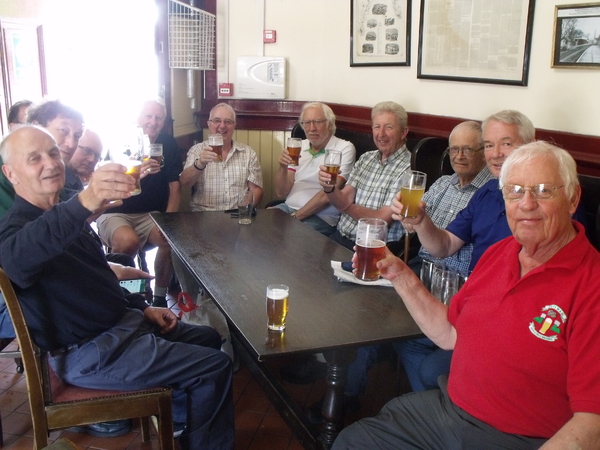
When the train arrived, it was pulled by a diesel engine: steam locos have been sidelined for the moment due to the risk of fire, with Saddleworth Moor and other open land in the area still facing problems. It was good to sit in comfort, compared to the cramped miseries of modern trains, as the train made its way through stunning countryside, criss-crossed with rivers, to Bury.
The station in Bury is officially known as Bury Bolton Street as the town had two stations until Dr Beeching arrived like the Grim Reaper. The Trackside Bar on Platform 2 is spacious and is complemented by ample tables and seats on the platform itself. Inside, steam buffs will think they have gone to loco paradise with the array of railway memorabilia, including old station signs (below). The large bar area serves Outstanding Piston Broke and 11 changing guest beers. On the evening of my visit Blackjack Brewery from Manchester was offering samples of many of its beers as their contribution to Manchester Beer Week.
They include several hoppy pale ales and IPAs, saison, including one infused with Jasmine tea, a German-style wheat beer, stout and – of great interest – the brewery’s interpretation of the Bavarian speciality, Dampfbier. This means steam beer and is a warm-fermented style that is unfined and has a spicy and slightly acidic character. Along with the Rawtenstall bar, Trackside also offers two good lagers, Krombacher from Germany and Czech Budweiser Budvar, and 10 ciders and perries: the bar was named local CAMRA cider pub of the year in 2016.
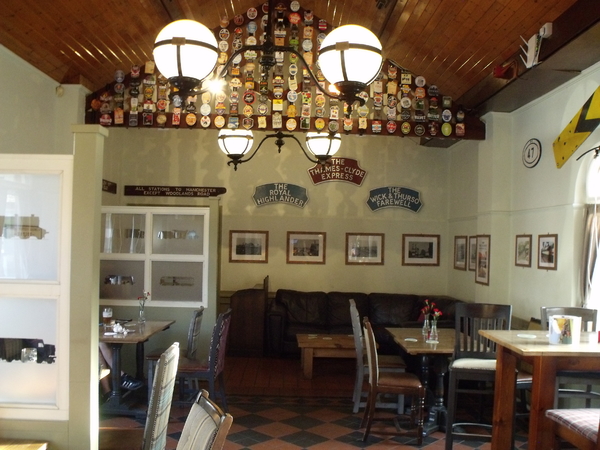
Both bars are owned by East Lancs Railway but they are run by a vastly experienced licensed trade entrepreneur, Will Parry. Will left university with an economics degree and ran the bar at an art house and gallery.
“I’ve always worked for independent breweries,” he says. “I started with Hoegaarden in the 1990s [before AB InBev took over] and selling cloudy beer was a battle then. Now I sell unfined cloudy cask ale!
“I’ve always been passionate about beer. When I took over Trackside, there was a low skills base and I had to train people in cellar techniques.
“Bury is a mini beer festival every weekend. We have 12 lines on. The Bury bar was a cafe that we refurbished and turned into a bar. We’ve made it attractive to women and we sell gin as well as beer and cider. There’s a small food offering at weekends.”
There are regular Meet the Brewer evenings, using brewers from the area. Will says 80% per cent of the beers sold in both bars are local cask and keg.
The trains run from Wednesday to Sunday and travellers can visit a museum at Bury with a collection of old trains, buses and steam engines.
East Lancs is currently attempting to raise the funds to by a loco, City of Wells, from a private owner who wants £350,000. You can help by supping as much beer at the two bars as you can.
www.eastlancsrailway.co.uk
*A few yards from Bury station, fnd time to drop into the Good Beer Guide-listed Clarence, 2 Silver Street. This is a gastro-pub with its own brewery serving Silver Street Session and several other beers brewed on the premises along with beers from other northern breweries. There's excellent food and the beautifully restored building stetrches over four floors, including a members' cocktail bar. Not to be missed.
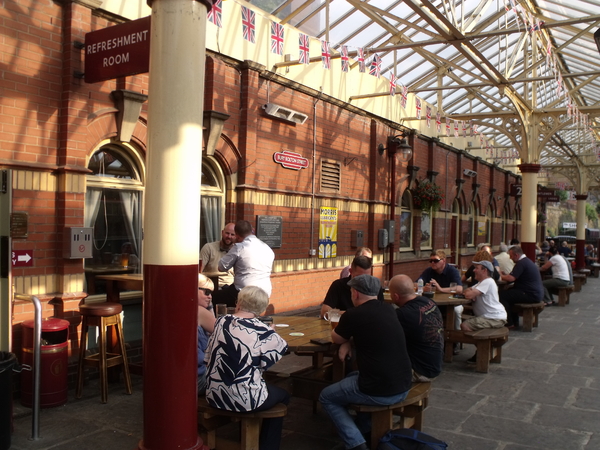
*En route to Rawtenstall, Will and I dropped in on the Northern Whisper Brewery at Rossendale. It opened in 2017 and is run by a experienced brewer Carmello Pillitteri and two brothers, Josh and Barney Vines.
The 10-barrel kit was built locally by Vincent Johnson in Bury and is already producing a wide range of beers in cask and keg. They include Yammerhouse American IPA (4.5%), Oppenchops, a 4% golden ale – the name is local slang for gossip – Blighty Bitter (3.8%), a 4.8% stout called Beltie, a sour beer and a German-style Kölsch.
Carmello (pictured below) has added a keg IPA with blood oranges and pineapple and an oatmeal stout in cask form. He is ageing a 9% barley wine in a whisky cask for a year and has bought oak casks from the rum, wine and whisky industries for further wood ageing.
I was surprised – but pleased – to discover that Carmello uses 100 per cent Chevallier barley malt. This is the barley variety that was once the main grain used in brewing in the 19th and early 20th centuries but was eventually phased out by new, high-yielding varieties. But it has been revived and is being grown again in Norfolk and turned into brewing malt by Crisp Malt. Supplies are limited and I’m delighted a small batch has found its way to Lancashire.
